East End Computing: Communication in Health and Social Care Report
VerifiedAdded on 2020/07/22
|13
|4055
|80
Report
AI Summary
This report comprehensively examines communication within Health & Social Care organizations. It begins by exploring the use of communication skills and identifies inappropriate interpersonal communication methods. The report then delves into various communication theories, analyzing their application within the National Health Service (NHS) and discussing the impact of charters, codes of practice, and legislation on communication practices. Furthermore, it evaluates the effectiveness of organizational systems and policies in promoting healthy communication. The report also investigates the benefits and legal considerations of Information and Communication Technologies (ICT) in health and social care, concluding with effective solutions to problems associated with ICT use. The report uses examples like the case of Mrs. Gina, a patient, to illustrate the application of communication theories and legislative requirements. The report emphasizes the importance of confidentiality, equality, and ethical behavior in health care settings and highlights the role of effective communication in providing quality care, reducing risks, and improving patient outcomes.
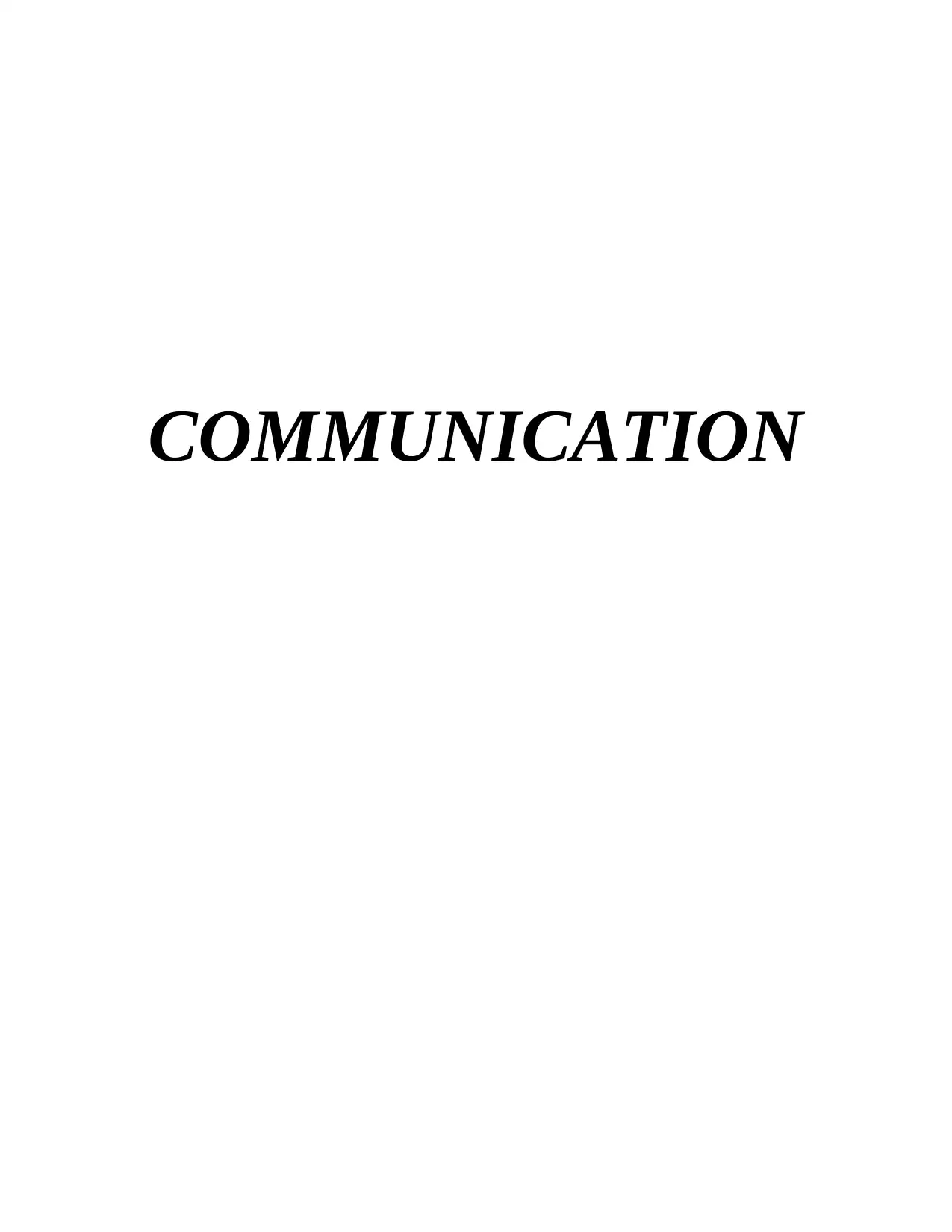
COMMUNICATION
Paraphrase This Document
Need a fresh take? Get an instant paraphrase of this document with our AI Paraphraser
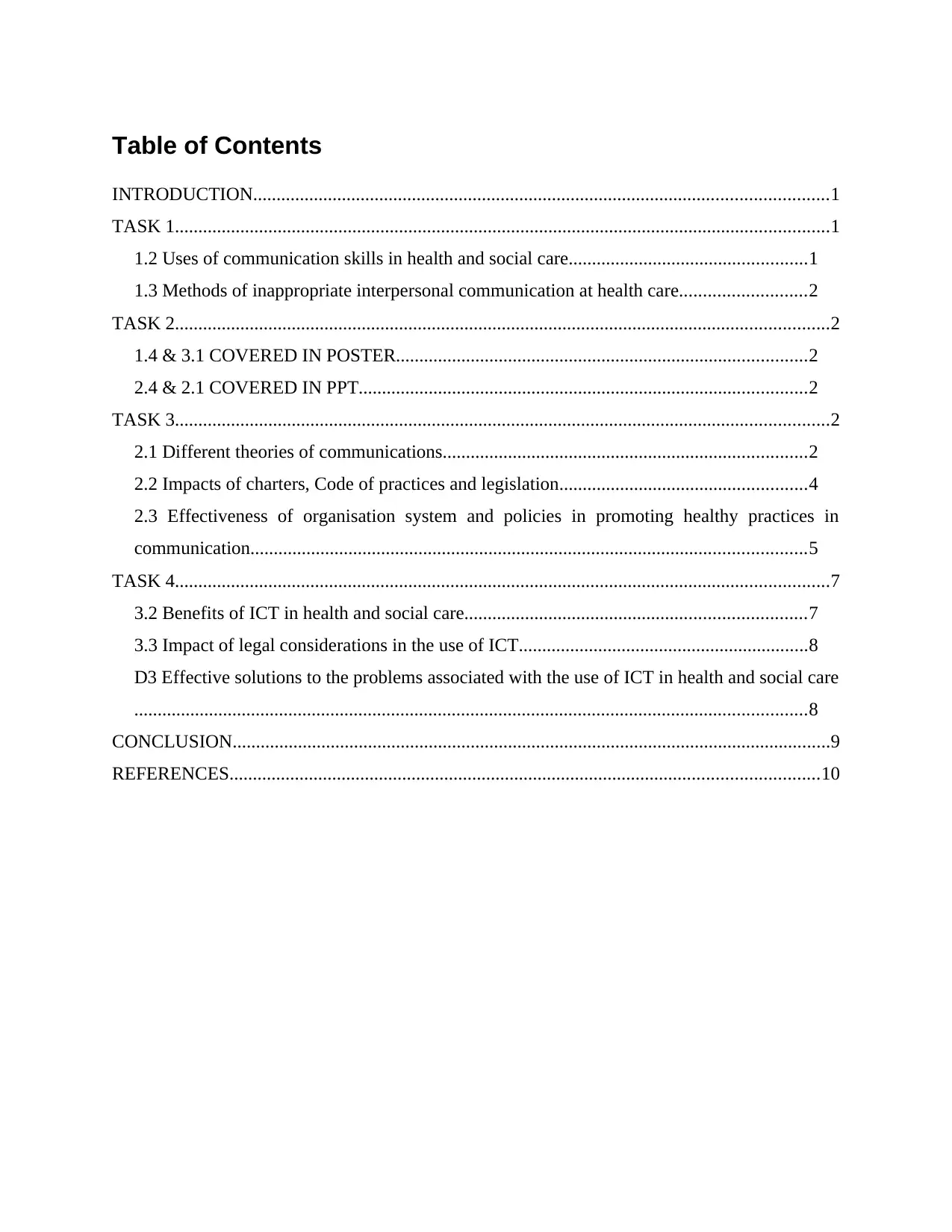
Table of Contents
INTRODUCTION...........................................................................................................................1
TASK 1............................................................................................................................................1
1.2 Uses of communication skills in health and social care...................................................1
1.3 Methods of inappropriate interpersonal communication at health care...........................2
TASK 2............................................................................................................................................2
1.4 & 3.1 COVERED IN POSTER........................................................................................2
2.4 & 2.1 COVERED IN PPT................................................................................................2
TASK 3............................................................................................................................................2
2.1 Different theories of communications..............................................................................2
2.2 Impacts of charters, Code of practices and legislation.....................................................4
2.3 Effectiveness of organisation system and policies in promoting healthy practices in
communication.......................................................................................................................5
TASK 4............................................................................................................................................7
3.2 Benefits of ICT in health and social care.........................................................................7
3.3 Impact of legal considerations in the use of ICT..............................................................8
D3 Effective solutions to the problems associated with the use of ICT in health and social care
................................................................................................................................................8
CONCLUSION................................................................................................................................9
REFERENCES..............................................................................................................................10
INTRODUCTION...........................................................................................................................1
TASK 1............................................................................................................................................1
1.2 Uses of communication skills in health and social care...................................................1
1.3 Methods of inappropriate interpersonal communication at health care...........................2
TASK 2............................................................................................................................................2
1.4 & 3.1 COVERED IN POSTER........................................................................................2
2.4 & 2.1 COVERED IN PPT................................................................................................2
TASK 3............................................................................................................................................2
2.1 Different theories of communications..............................................................................2
2.2 Impacts of charters, Code of practices and legislation.....................................................4
2.3 Effectiveness of organisation system and policies in promoting healthy practices in
communication.......................................................................................................................5
TASK 4............................................................................................................................................7
3.2 Benefits of ICT in health and social care.........................................................................7
3.3 Impact of legal considerations in the use of ICT..............................................................8
D3 Effective solutions to the problems associated with the use of ICT in health and social care
................................................................................................................................................8
CONCLUSION................................................................................................................................9
REFERENCES..............................................................................................................................10
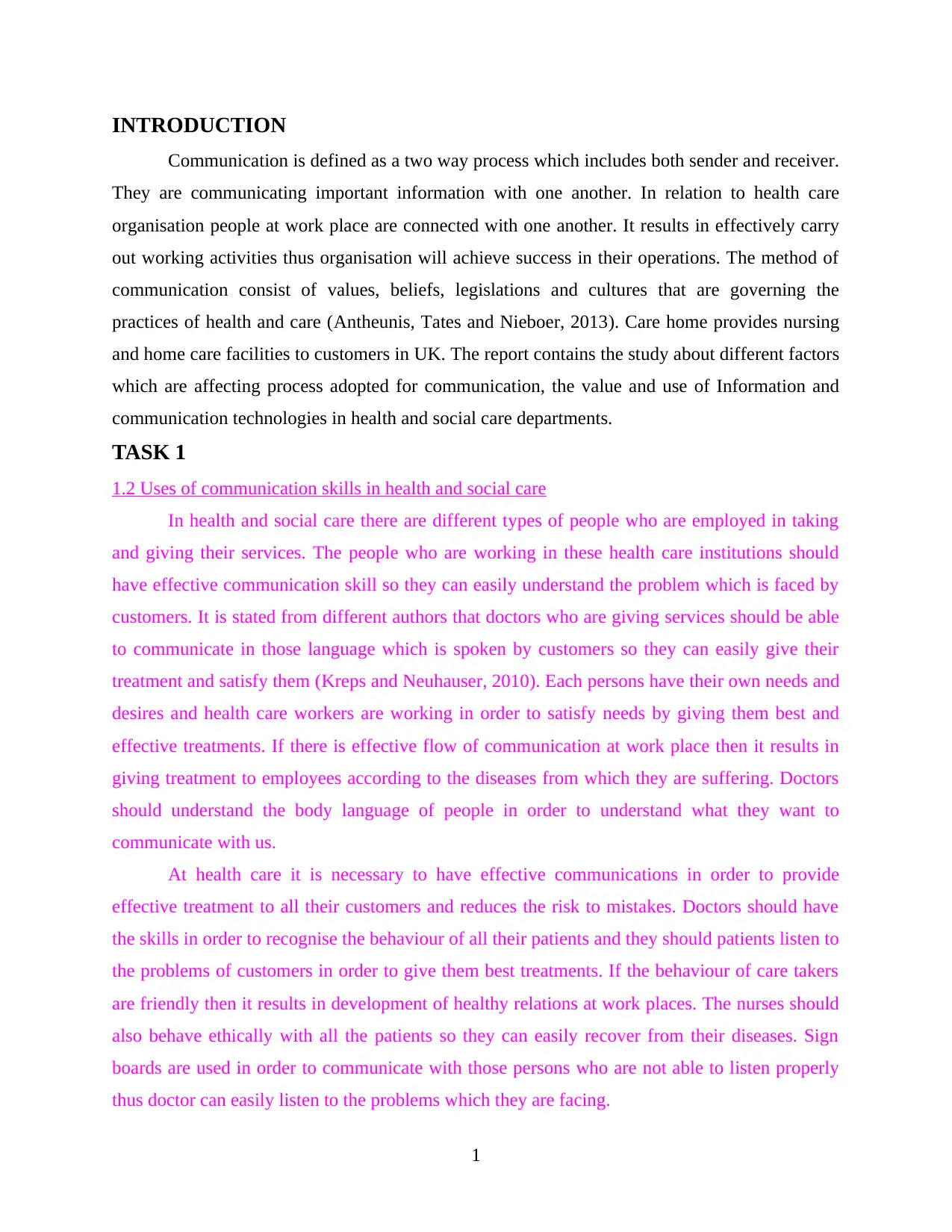
INTRODUCTION
Communication is defined as a two way process which includes both sender and receiver.
They are communicating important information with one another. In relation to health care
organisation people at work place are connected with one another. It results in effectively carry
out working activities thus organisation will achieve success in their operations. The method of
communication consist of values, beliefs, legislations and cultures that are governing the
practices of health and care (Antheunis, Tates and Nieboer, 2013). Care home provides nursing
and home care facilities to customers in UK. The report contains the study about different factors
which are affecting process adopted for communication, the value and use of Information and
communication technologies in health and social care departments.
TASK 1
1.2 Uses of communication skills in health and social care
In health and social care there are different types of people who are employed in taking
and giving their services. The people who are working in these health care institutions should
have effective communication skill so they can easily understand the problem which is faced by
customers. It is stated from different authors that doctors who are giving services should be able
to communicate in those language which is spoken by customers so they can easily give their
treatment and satisfy them (Kreps and Neuhauser, 2010). Each persons have their own needs and
desires and health care workers are working in order to satisfy needs by giving them best and
effective treatments. If there is effective flow of communication at work place then it results in
giving treatment to employees according to the diseases from which they are suffering. Doctors
should understand the body language of people in order to understand what they want to
communicate with us.
At health care it is necessary to have effective communications in order to provide
effective treatment to all their customers and reduces the risk to mistakes. Doctors should have
the skills in order to recognise the behaviour of all their patients and they should patients listen to
the problems of customers in order to give them best treatments. If the behaviour of care takers
are friendly then it results in development of healthy relations at work places. The nurses should
also behave ethically with all the patients so they can easily recover from their diseases. Sign
boards are used in order to communicate with those persons who are not able to listen properly
thus doctor can easily listen to the problems which they are facing.
1
Communication is defined as a two way process which includes both sender and receiver.
They are communicating important information with one another. In relation to health care
organisation people at work place are connected with one another. It results in effectively carry
out working activities thus organisation will achieve success in their operations. The method of
communication consist of values, beliefs, legislations and cultures that are governing the
practices of health and care (Antheunis, Tates and Nieboer, 2013). Care home provides nursing
and home care facilities to customers in UK. The report contains the study about different factors
which are affecting process adopted for communication, the value and use of Information and
communication technologies in health and social care departments.
TASK 1
1.2 Uses of communication skills in health and social care
In health and social care there are different types of people who are employed in taking
and giving their services. The people who are working in these health care institutions should
have effective communication skill so they can easily understand the problem which is faced by
customers. It is stated from different authors that doctors who are giving services should be able
to communicate in those language which is spoken by customers so they can easily give their
treatment and satisfy them (Kreps and Neuhauser, 2010). Each persons have their own needs and
desires and health care workers are working in order to satisfy needs by giving them best and
effective treatments. If there is effective flow of communication at work place then it results in
giving treatment to employees according to the diseases from which they are suffering. Doctors
should understand the body language of people in order to understand what they want to
communicate with us.
At health care it is necessary to have effective communications in order to provide
effective treatment to all their customers and reduces the risk to mistakes. Doctors should have
the skills in order to recognise the behaviour of all their patients and they should patients listen to
the problems of customers in order to give them best treatments. If the behaviour of care takers
are friendly then it results in development of healthy relations at work places. The nurses should
also behave ethically with all the patients so they can easily recover from their diseases. Sign
boards are used in order to communicate with those persons who are not able to listen properly
thus doctor can easily listen to the problems which they are facing.
1
⊘ This is a preview!⊘
Do you want full access?
Subscribe today to unlock all pages.

Trusted by 1+ million students worldwide
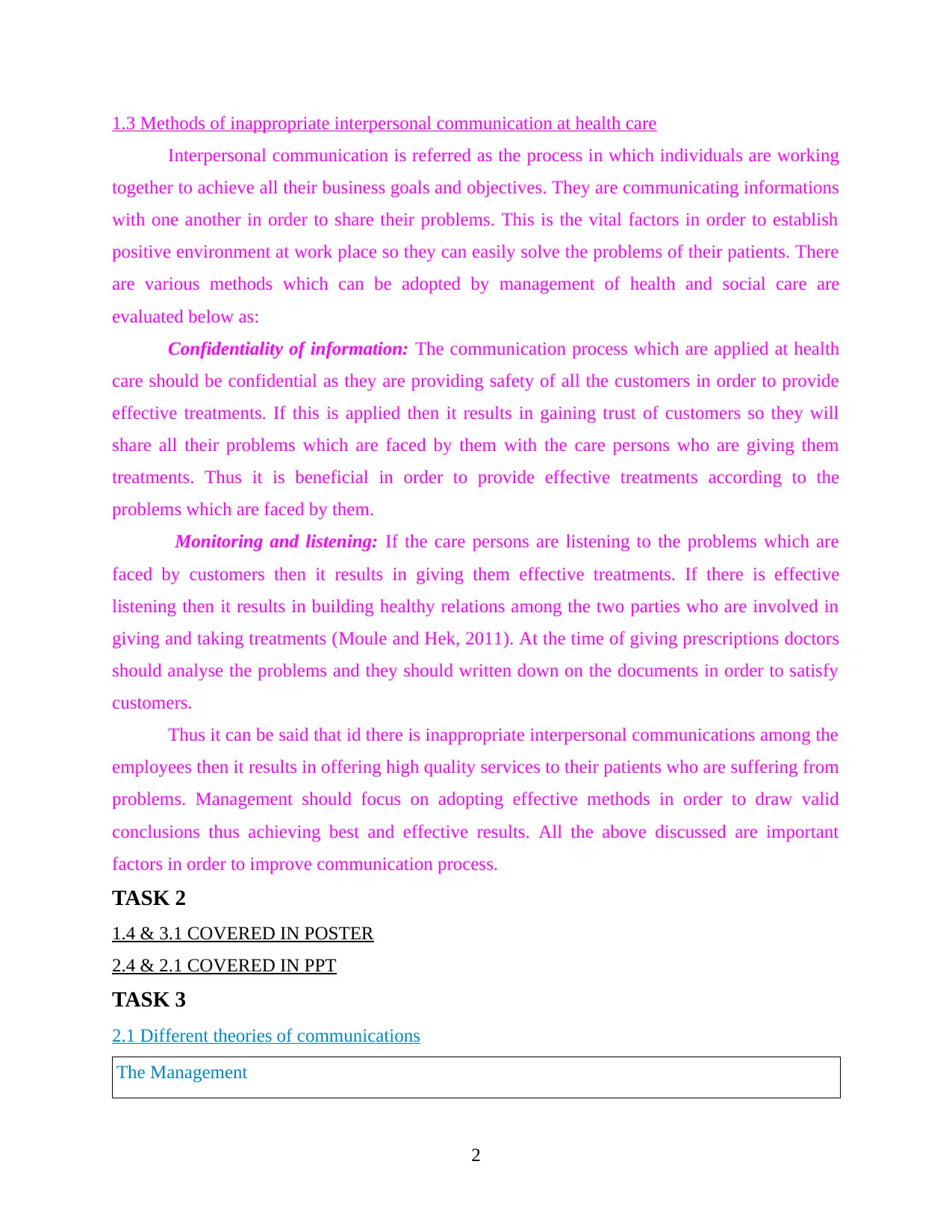
1.3 Methods of inappropriate interpersonal communication at health care
Interpersonal communication is referred as the process in which individuals are working
together to achieve all their business goals and objectives. They are communicating informations
with one another in order to share their problems. This is the vital factors in order to establish
positive environment at work place so they can easily solve the problems of their patients. There
are various methods which can be adopted by management of health and social care are
evaluated below as:
Confidentiality of information: The communication process which are applied at health
care should be confidential as they are providing safety of all the customers in order to provide
effective treatments. If this is applied then it results in gaining trust of customers so they will
share all their problems which are faced by them with the care persons who are giving them
treatments. Thus it is beneficial in order to provide effective treatments according to the
problems which are faced by them.
Monitoring and listening: If the care persons are listening to the problems which are
faced by customers then it results in giving them effective treatments. If there is effective
listening then it results in building healthy relations among the two parties who are involved in
giving and taking treatments (Moule and Hek, 2011). At the time of giving prescriptions doctors
should analyse the problems and they should written down on the documents in order to satisfy
customers.
Thus it can be said that id there is inappropriate interpersonal communications among the
employees then it results in offering high quality services to their patients who are suffering from
problems. Management should focus on adopting effective methods in order to draw valid
conclusions thus achieving best and effective results. All the above discussed are important
factors in order to improve communication process.
TASK 2
1.4 & 3.1 COVERED IN POSTER
2.4 & 2.1 COVERED IN PPT
TASK 3
2.1 Different theories of communications
The Management
2
Interpersonal communication is referred as the process in which individuals are working
together to achieve all their business goals and objectives. They are communicating informations
with one another in order to share their problems. This is the vital factors in order to establish
positive environment at work place so they can easily solve the problems of their patients. There
are various methods which can be adopted by management of health and social care are
evaluated below as:
Confidentiality of information: The communication process which are applied at health
care should be confidential as they are providing safety of all the customers in order to provide
effective treatments. If this is applied then it results in gaining trust of customers so they will
share all their problems which are faced by them with the care persons who are giving them
treatments. Thus it is beneficial in order to provide effective treatments according to the
problems which are faced by them.
Monitoring and listening: If the care persons are listening to the problems which are
faced by customers then it results in giving them effective treatments. If there is effective
listening then it results in building healthy relations among the two parties who are involved in
giving and taking treatments (Moule and Hek, 2011). At the time of giving prescriptions doctors
should analyse the problems and they should written down on the documents in order to satisfy
customers.
Thus it can be said that id there is inappropriate interpersonal communications among the
employees then it results in offering high quality services to their patients who are suffering from
problems. Management should focus on adopting effective methods in order to draw valid
conclusions thus achieving best and effective results. All the above discussed are important
factors in order to improve communication process.
TASK 2
1.4 & 3.1 COVERED IN POSTER
2.4 & 2.1 COVERED IN PPT
TASK 3
2.1 Different theories of communications
The Management
2
Paraphrase This Document
Need a fresh take? Get an instant paraphrase of this document with our AI Paraphraser
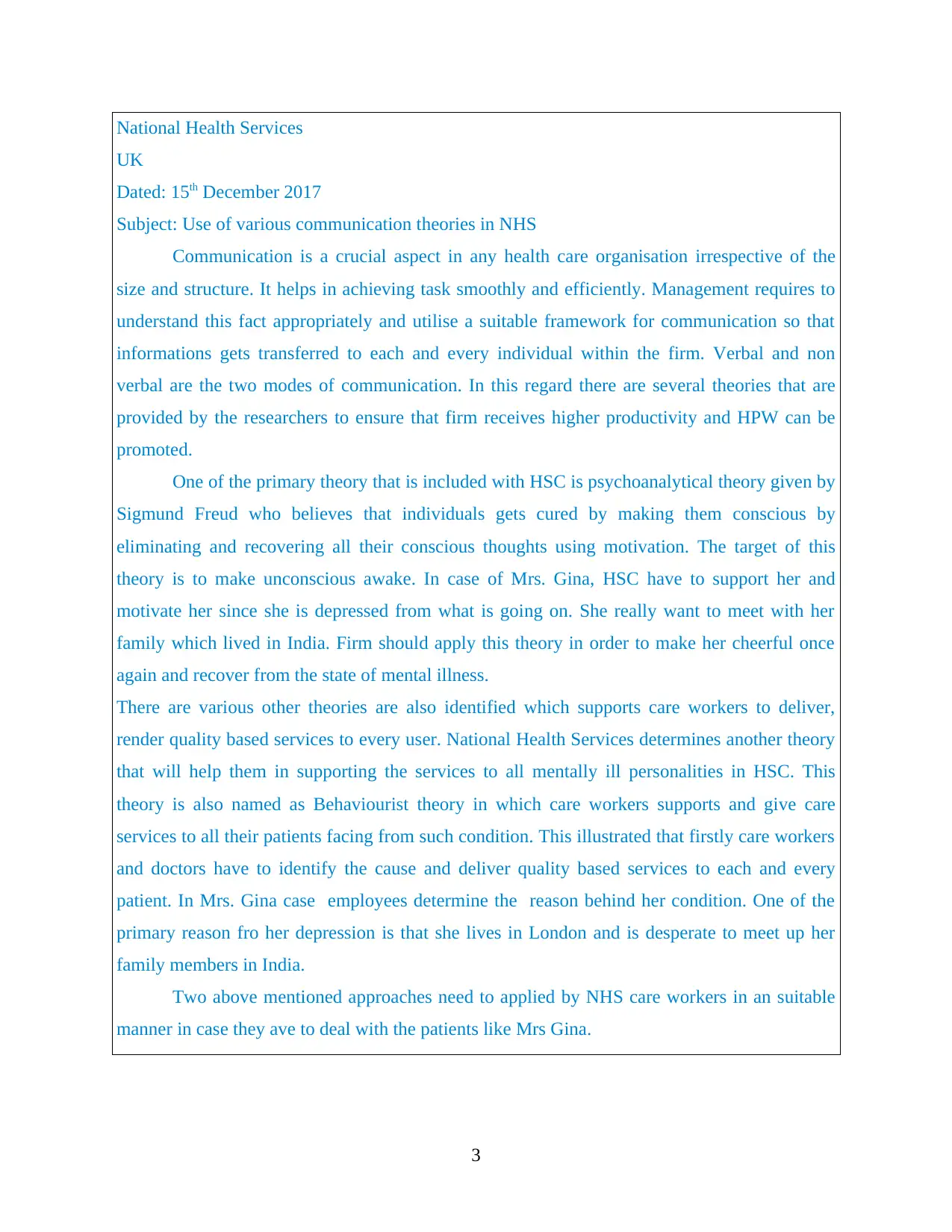
National Health Services
UK
Dated: 15th December 2017
Subject: Use of various communication theories in NHS
Communication is a crucial aspect in any health care organisation irrespective of the
size and structure. It helps in achieving task smoothly and efficiently. Management requires to
understand this fact appropriately and utilise a suitable framework for communication so that
informations gets transferred to each and every individual within the firm. Verbal and non
verbal are the two modes of communication. In this regard there are several theories that are
provided by the researchers to ensure that firm receives higher productivity and HPW can be
promoted.
One of the primary theory that is included with HSC is psychoanalytical theory given by
Sigmund Freud who believes that individuals gets cured by making them conscious by
eliminating and recovering all their conscious thoughts using motivation. The target of this
theory is to make unconscious awake. In case of Mrs. Gina, HSC have to support her and
motivate her since she is depressed from what is going on. She really want to meet with her
family which lived in India. Firm should apply this theory in order to make her cheerful once
again and recover from the state of mental illness.
There are various other theories are also identified which supports care workers to deliver,
render quality based services to every user. National Health Services determines another theory
that will help them in supporting the services to all mentally ill personalities in HSC. This
theory is also named as Behaviourist theory in which care workers supports and give care
services to all their patients facing from such condition. This illustrated that firstly care workers
and doctors have to identify the cause and deliver quality based services to each and every
patient. In Mrs. Gina case employees determine the reason behind her condition. One of the
primary reason fro her depression is that she lives in London and is desperate to meet up her
family members in India.
Two above mentioned approaches need to applied by NHS care workers in an suitable
manner in case they ave to deal with the patients like Mrs Gina.
3
UK
Dated: 15th December 2017
Subject: Use of various communication theories in NHS
Communication is a crucial aspect in any health care organisation irrespective of the
size and structure. It helps in achieving task smoothly and efficiently. Management requires to
understand this fact appropriately and utilise a suitable framework for communication so that
informations gets transferred to each and every individual within the firm. Verbal and non
verbal are the two modes of communication. In this regard there are several theories that are
provided by the researchers to ensure that firm receives higher productivity and HPW can be
promoted.
One of the primary theory that is included with HSC is psychoanalytical theory given by
Sigmund Freud who believes that individuals gets cured by making them conscious by
eliminating and recovering all their conscious thoughts using motivation. The target of this
theory is to make unconscious awake. In case of Mrs. Gina, HSC have to support her and
motivate her since she is depressed from what is going on. She really want to meet with her
family which lived in India. Firm should apply this theory in order to make her cheerful once
again and recover from the state of mental illness.
There are various other theories are also identified which supports care workers to deliver,
render quality based services to every user. National Health Services determines another theory
that will help them in supporting the services to all mentally ill personalities in HSC. This
theory is also named as Behaviourist theory in which care workers supports and give care
services to all their patients facing from such condition. This illustrated that firstly care workers
and doctors have to identify the cause and deliver quality based services to each and every
patient. In Mrs. Gina case employees determine the reason behind her condition. One of the
primary reason fro her depression is that she lives in London and is desperate to meet up her
family members in India.
Two above mentioned approaches need to applied by NHS care workers in an suitable
manner in case they ave to deal with the patients like Mrs Gina.
3
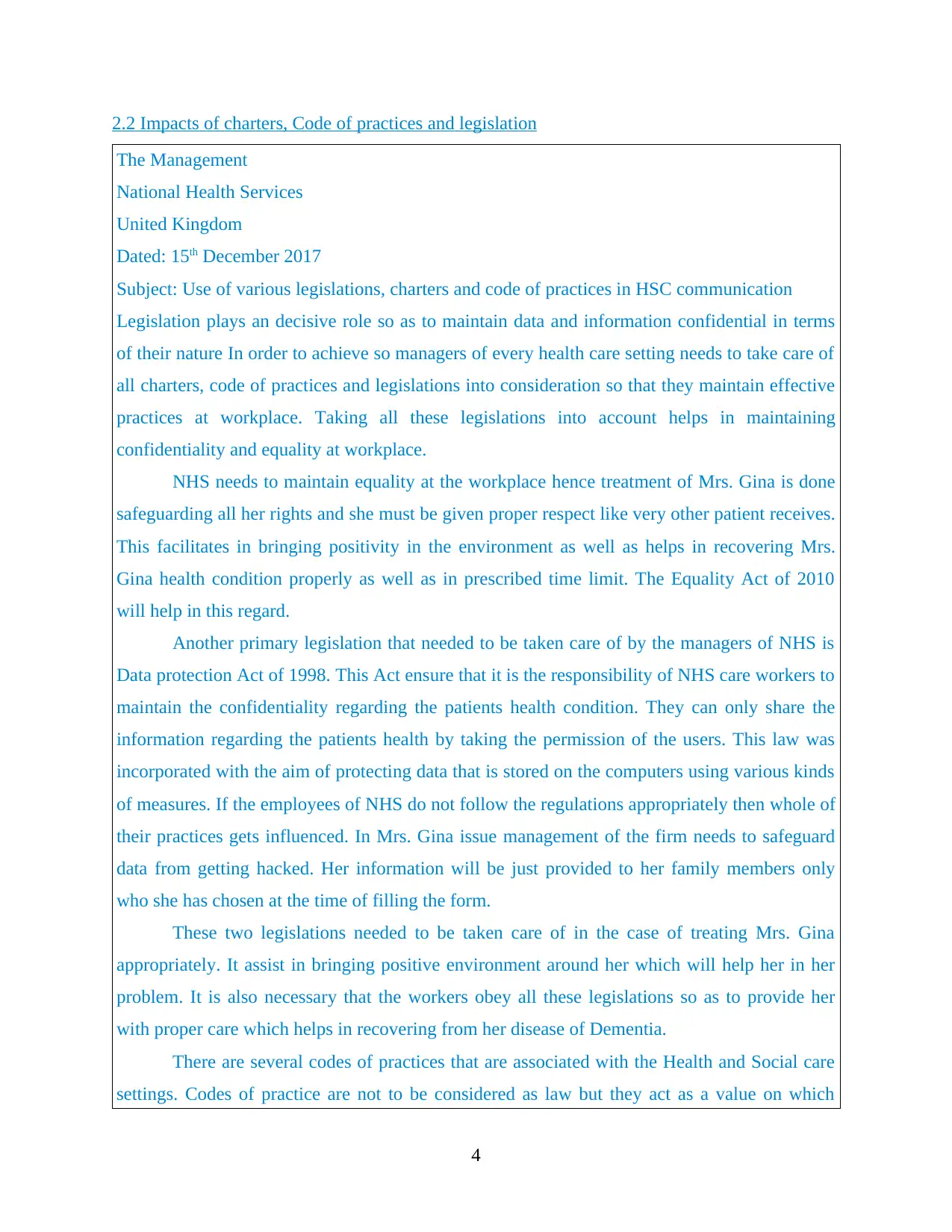
2.2 Impacts of charters, Code of practices and legislation
The Management
National Health Services
United Kingdom
Dated: 15th December 2017
Subject: Use of various legislations, charters and code of practices in HSC communication
Legislation plays an decisive role so as to maintain data and information confidential in terms
of their nature In order to achieve so managers of every health care setting needs to take care of
all charters, code of practices and legislations into consideration so that they maintain effective
practices at workplace. Taking all these legislations into account helps in maintaining
confidentiality and equality at workplace.
NHS needs to maintain equality at the workplace hence treatment of Mrs. Gina is done
safeguarding all her rights and she must be given proper respect like very other patient receives.
This facilitates in bringing positivity in the environment as well as helps in recovering Mrs.
Gina health condition properly as well as in prescribed time limit. The Equality Act of 2010
will help in this regard.
Another primary legislation that needed to be taken care of by the managers of NHS is
Data protection Act of 1998. This Act ensure that it is the responsibility of NHS care workers to
maintain the confidentiality regarding the patients health condition. They can only share the
information regarding the patients health by taking the permission of the users. This law was
incorporated with the aim of protecting data that is stored on the computers using various kinds
of measures. If the employees of NHS do not follow the regulations appropriately then whole of
their practices gets influenced. In Mrs. Gina issue management of the firm needs to safeguard
data from getting hacked. Her information will be just provided to her family members only
who she has chosen at the time of filling the form.
These two legislations needed to be taken care of in the case of treating Mrs. Gina
appropriately. It assist in bringing positive environment around her which will help her in her
problem. It is also necessary that the workers obey all these legislations so as to provide her
with proper care which helps in recovering from her disease of Dementia.
There are several codes of practices that are associated with the Health and Social care
settings. Codes of practice are not to be considered as law but they act as a value on which
4
The Management
National Health Services
United Kingdom
Dated: 15th December 2017
Subject: Use of various legislations, charters and code of practices in HSC communication
Legislation plays an decisive role so as to maintain data and information confidential in terms
of their nature In order to achieve so managers of every health care setting needs to take care of
all charters, code of practices and legislations into consideration so that they maintain effective
practices at workplace. Taking all these legislations into account helps in maintaining
confidentiality and equality at workplace.
NHS needs to maintain equality at the workplace hence treatment of Mrs. Gina is done
safeguarding all her rights and she must be given proper respect like very other patient receives.
This facilitates in bringing positivity in the environment as well as helps in recovering Mrs.
Gina health condition properly as well as in prescribed time limit. The Equality Act of 2010
will help in this regard.
Another primary legislation that needed to be taken care of by the managers of NHS is
Data protection Act of 1998. This Act ensure that it is the responsibility of NHS care workers to
maintain the confidentiality regarding the patients health condition. They can only share the
information regarding the patients health by taking the permission of the users. This law was
incorporated with the aim of protecting data that is stored on the computers using various kinds
of measures. If the employees of NHS do not follow the regulations appropriately then whole of
their practices gets influenced. In Mrs. Gina issue management of the firm needs to safeguard
data from getting hacked. Her information will be just provided to her family members only
who she has chosen at the time of filling the form.
These two legislations needed to be taken care of in the case of treating Mrs. Gina
appropriately. It assist in bringing positive environment around her which will help her in her
problem. It is also necessary that the workers obey all these legislations so as to provide her
with proper care which helps in recovering from her disease of Dementia.
There are several codes of practices that are associated with the Health and Social care
settings. Codes of practice are not to be considered as law but they act as a value on which
4
⊘ This is a preview!⊘
Do you want full access?
Subscribe today to unlock all pages.

Trusted by 1+ million students worldwide
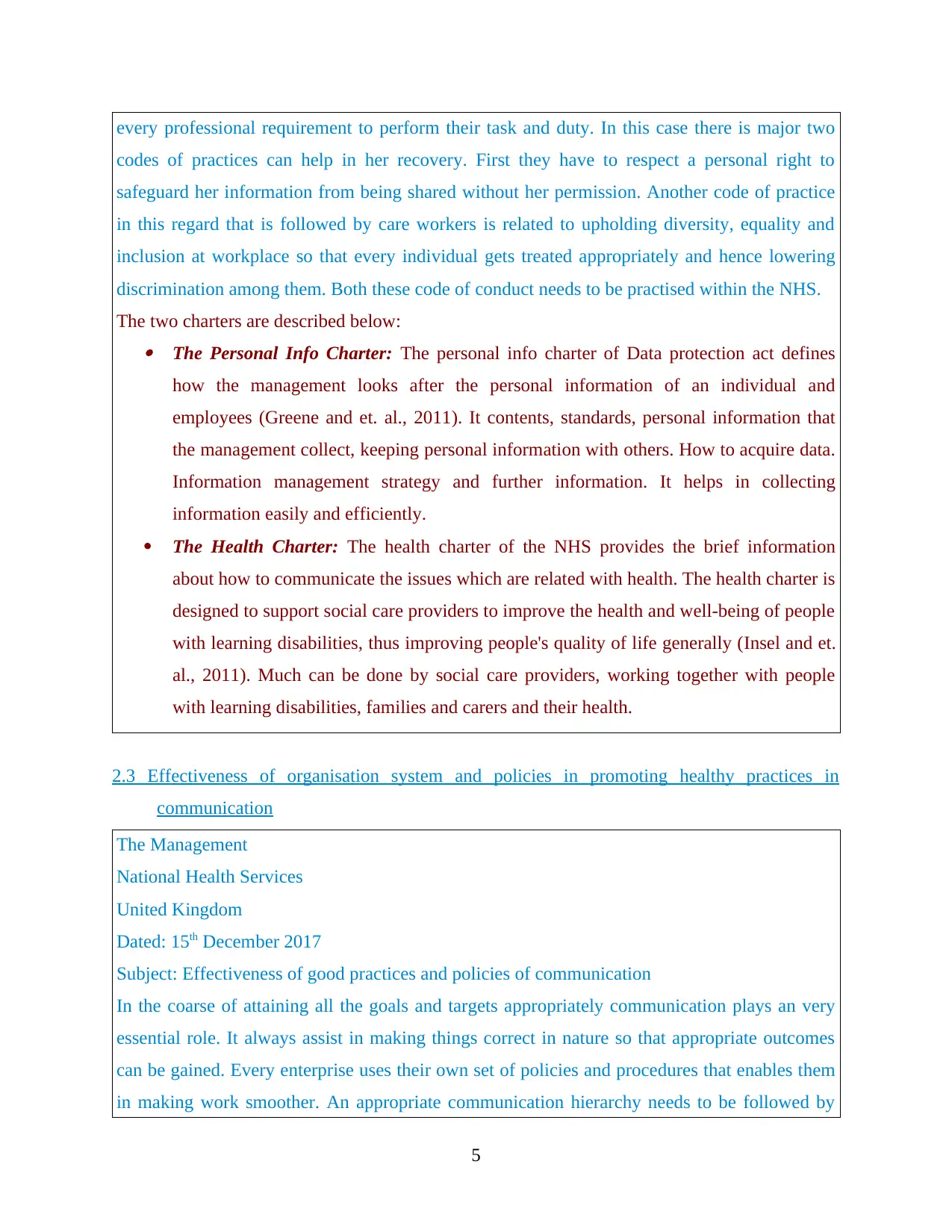
every professional requirement to perform their task and duty. In this case there is major two
codes of practices can help in her recovery. First they have to respect a personal right to
safeguard her information from being shared without her permission. Another code of practice
in this regard that is followed by care workers is related to upholding diversity, equality and
inclusion at workplace so that every individual gets treated appropriately and hence lowering
discrimination among them. Both these code of conduct needs to be practised within the NHS.
The two charters are described below: The Personal Info Charter: The personal info charter of Data protection act defines
how the management looks after the personal information of an individual and
employees (Greene and et. al., 2011). It contents, standards, personal information that
the management collect, keeping personal information with others. How to acquire data.
Information management strategy and further information. It helps in collecting
information easily and efficiently.
The Health Charter: The health charter of the NHS provides the brief information
about how to communicate the issues which are related with health. The health charter is
designed to support social care providers to improve the health and well-being of people
with learning disabilities, thus improving people's quality of life generally (Insel and et.
al., 2011). Much can be done by social care providers, working together with people
with learning disabilities, families and carers and their health.
2.3 Effectiveness of organisation system and policies in promoting healthy practices in
communication
The Management
National Health Services
United Kingdom
Dated: 15th December 2017
Subject: Effectiveness of good practices and policies of communication
In the coarse of attaining all the goals and targets appropriately communication plays an very
essential role. It always assist in making things correct in nature so that appropriate outcomes
can be gained. Every enterprise uses their own set of policies and procedures that enables them
in making work smoother. An appropriate communication hierarchy needs to be followed by
5
codes of practices can help in her recovery. First they have to respect a personal right to
safeguard her information from being shared without her permission. Another code of practice
in this regard that is followed by care workers is related to upholding diversity, equality and
inclusion at workplace so that every individual gets treated appropriately and hence lowering
discrimination among them. Both these code of conduct needs to be practised within the NHS.
The two charters are described below: The Personal Info Charter: The personal info charter of Data protection act defines
how the management looks after the personal information of an individual and
employees (Greene and et. al., 2011). It contents, standards, personal information that
the management collect, keeping personal information with others. How to acquire data.
Information management strategy and further information. It helps in collecting
information easily and efficiently.
The Health Charter: The health charter of the NHS provides the brief information
about how to communicate the issues which are related with health. The health charter is
designed to support social care providers to improve the health and well-being of people
with learning disabilities, thus improving people's quality of life generally (Insel and et.
al., 2011). Much can be done by social care providers, working together with people
with learning disabilities, families and carers and their health.
2.3 Effectiveness of organisation system and policies in promoting healthy practices in
communication
The Management
National Health Services
United Kingdom
Dated: 15th December 2017
Subject: Effectiveness of good practices and policies of communication
In the coarse of attaining all the goals and targets appropriately communication plays an very
essential role. It always assist in making things correct in nature so that appropriate outcomes
can be gained. Every enterprise uses their own set of policies and procedures that enables them
in making work smoother. An appropriate communication hierarchy needs to be followed by
5
Paraphrase This Document
Need a fresh take? Get an instant paraphrase of this document with our AI Paraphraser
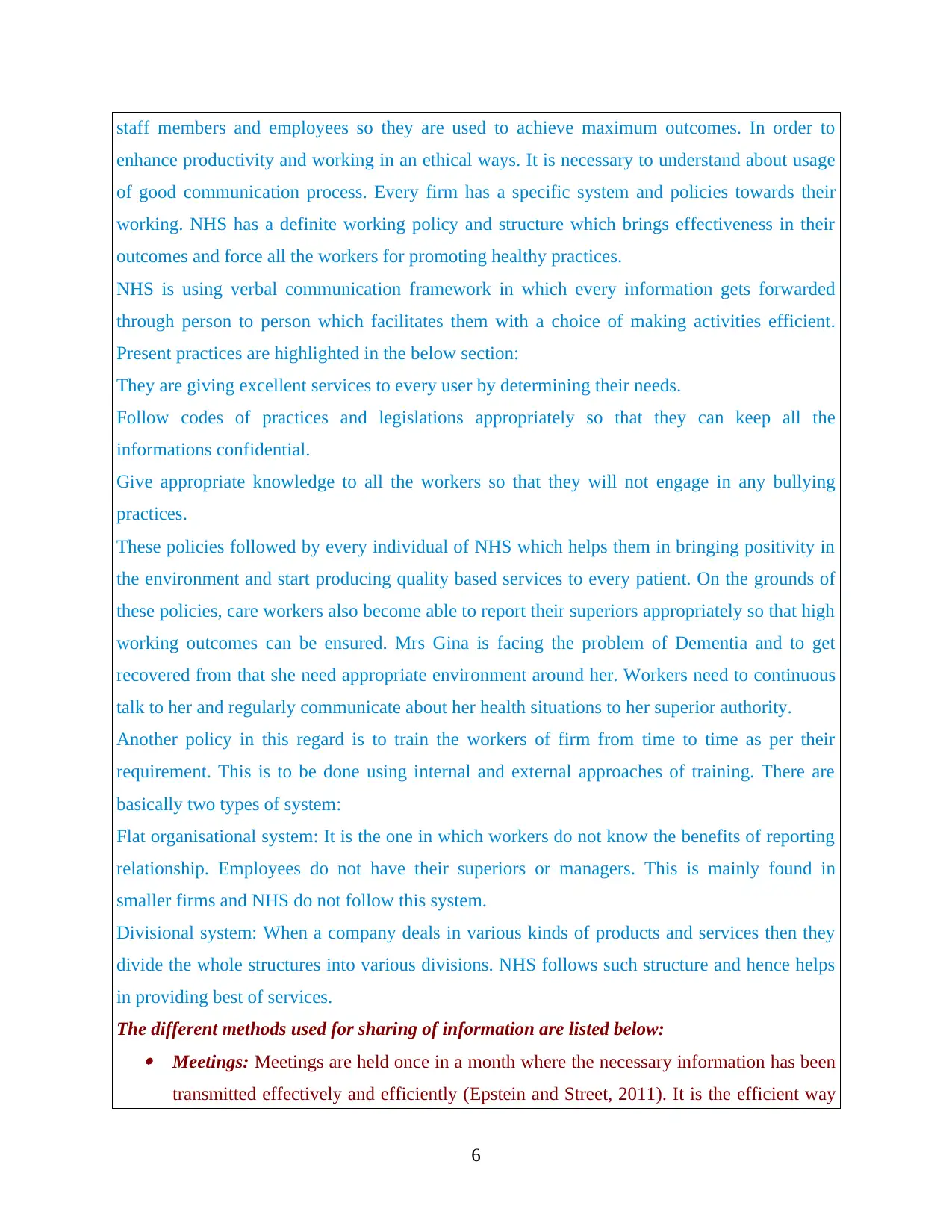
staff members and employees so they are used to achieve maximum outcomes. In order to
enhance productivity and working in an ethical ways. It is necessary to understand about usage
of good communication process. Every firm has a specific system and policies towards their
working. NHS has a definite working policy and structure which brings effectiveness in their
outcomes and force all the workers for promoting healthy practices.
NHS is using verbal communication framework in which every information gets forwarded
through person to person which facilitates them with a choice of making activities efficient.
Present practices are highlighted in the below section:
They are giving excellent services to every user by determining their needs.
Follow codes of practices and legislations appropriately so that they can keep all the
informations confidential.
Give appropriate knowledge to all the workers so that they will not engage in any bullying
practices.
These policies followed by every individual of NHS which helps them in bringing positivity in
the environment and start producing quality based services to every patient. On the grounds of
these policies, care workers also become able to report their superiors appropriately so that high
working outcomes can be ensured. Mrs Gina is facing the problem of Dementia and to get
recovered from that she need appropriate environment around her. Workers need to continuous
talk to her and regularly communicate about her health situations to her superior authority.
Another policy in this regard is to train the workers of firm from time to time as per their
requirement. This is to be done using internal and external approaches of training. There are
basically two types of system:
Flat organisational system: It is the one in which workers do not know the benefits of reporting
relationship. Employees do not have their superiors or managers. This is mainly found in
smaller firms and NHS do not follow this system.
Divisional system: When a company deals in various kinds of products and services then they
divide the whole structures into various divisions. NHS follows such structure and hence helps
in providing best of services.
The different methods used for sharing of information are listed below: Meetings: Meetings are held once in a month where the necessary information has been
transmitted effectively and efficiently (Epstein and Street, 2011). It is the efficient way
6
enhance productivity and working in an ethical ways. It is necessary to understand about usage
of good communication process. Every firm has a specific system and policies towards their
working. NHS has a definite working policy and structure which brings effectiveness in their
outcomes and force all the workers for promoting healthy practices.
NHS is using verbal communication framework in which every information gets forwarded
through person to person which facilitates them with a choice of making activities efficient.
Present practices are highlighted in the below section:
They are giving excellent services to every user by determining their needs.
Follow codes of practices and legislations appropriately so that they can keep all the
informations confidential.
Give appropriate knowledge to all the workers so that they will not engage in any bullying
practices.
These policies followed by every individual of NHS which helps them in bringing positivity in
the environment and start producing quality based services to every patient. On the grounds of
these policies, care workers also become able to report their superiors appropriately so that high
working outcomes can be ensured. Mrs Gina is facing the problem of Dementia and to get
recovered from that she need appropriate environment around her. Workers need to continuous
talk to her and regularly communicate about her health situations to her superior authority.
Another policy in this regard is to train the workers of firm from time to time as per their
requirement. This is to be done using internal and external approaches of training. There are
basically two types of system:
Flat organisational system: It is the one in which workers do not know the benefits of reporting
relationship. Employees do not have their superiors or managers. This is mainly found in
smaller firms and NHS do not follow this system.
Divisional system: When a company deals in various kinds of products and services then they
divide the whole structures into various divisions. NHS follows such structure and hence helps
in providing best of services.
The different methods used for sharing of information are listed below: Meetings: Meetings are held once in a month where the necessary information has been
transmitted effectively and efficiently (Epstein and Street, 2011). It is the efficient way
6
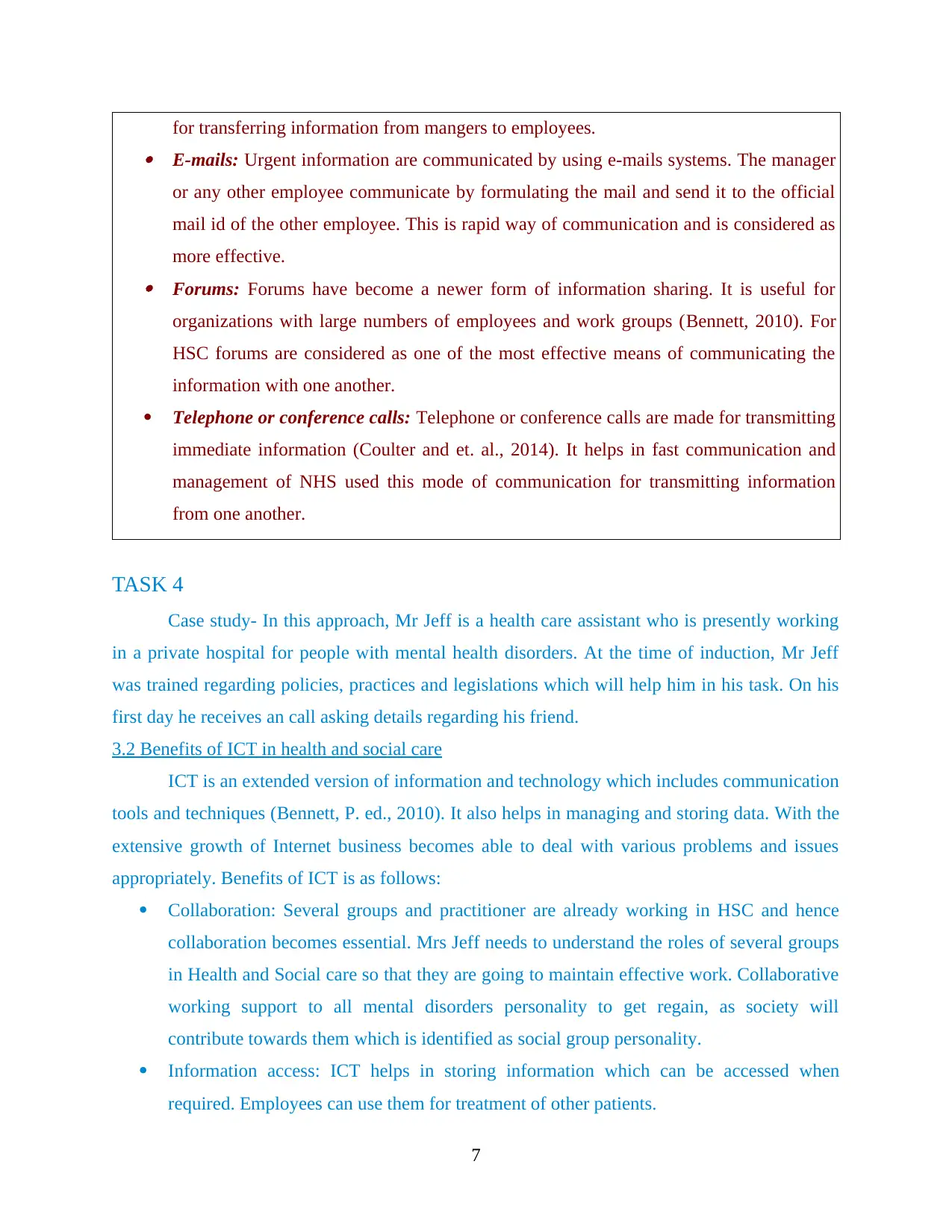
for transferring information from mangers to employees. E-mails: Urgent information are communicated by using e-mails systems. The manager
or any other employee communicate by formulating the mail and send it to the official
mail id of the other employee. This is rapid way of communication and is considered as
more effective. Forums: Forums have become a newer form of information sharing. It is useful for
organizations with large numbers of employees and work groups (Bennett, 2010). For
HSC forums are considered as one of the most effective means of communicating the
information with one another.
Telephone or conference calls: Telephone or conference calls are made for transmitting
immediate information (Coulter and et. al., 2014). It helps in fast communication and
management of NHS used this mode of communication for transmitting information
from one another.
TASK 4
Case study- In this approach, Mr Jeff is a health care assistant who is presently working
in a private hospital for people with mental health disorders. At the time of induction, Mr Jeff
was trained regarding policies, practices and legislations which will help him in his task. On his
first day he receives an call asking details regarding his friend.
3.2 Benefits of ICT in health and social care
ICT is an extended version of information and technology which includes communication
tools and techniques (Bennett, P. ed., 2010). It also helps in managing and storing data. With the
extensive growth of Internet business becomes able to deal with various problems and issues
appropriately. Benefits of ICT is as follows:
Collaboration: Several groups and practitioner are already working in HSC and hence
collaboration becomes essential. Mrs Jeff needs to understand the roles of several groups
in Health and Social care so that they are going to maintain effective work. Collaborative
working support to all mental disorders personality to get regain, as society will
contribute towards them which is identified as social group personality.
Information access: ICT helps in storing information which can be accessed when
required. Employees can use them for treatment of other patients.
7
or any other employee communicate by formulating the mail and send it to the official
mail id of the other employee. This is rapid way of communication and is considered as
more effective. Forums: Forums have become a newer form of information sharing. It is useful for
organizations with large numbers of employees and work groups (Bennett, 2010). For
HSC forums are considered as one of the most effective means of communicating the
information with one another.
Telephone or conference calls: Telephone or conference calls are made for transmitting
immediate information (Coulter and et. al., 2014). It helps in fast communication and
management of NHS used this mode of communication for transmitting information
from one another.
TASK 4
Case study- In this approach, Mr Jeff is a health care assistant who is presently working
in a private hospital for people with mental health disorders. At the time of induction, Mr Jeff
was trained regarding policies, practices and legislations which will help him in his task. On his
first day he receives an call asking details regarding his friend.
3.2 Benefits of ICT in health and social care
ICT is an extended version of information and technology which includes communication
tools and techniques (Bennett, P. ed., 2010). It also helps in managing and storing data. With the
extensive growth of Internet business becomes able to deal with various problems and issues
appropriately. Benefits of ICT is as follows:
Collaboration: Several groups and practitioner are already working in HSC and hence
collaboration becomes essential. Mrs Jeff needs to understand the roles of several groups
in Health and Social care so that they are going to maintain effective work. Collaborative
working support to all mental disorders personality to get regain, as society will
contribute towards them which is identified as social group personality.
Information access: ICT helps in storing information which can be accessed when
required. Employees can use them for treatment of other patients.
7
⊘ This is a preview!⊘
Do you want full access?
Subscribe today to unlock all pages.

Trusted by 1+ million students worldwide
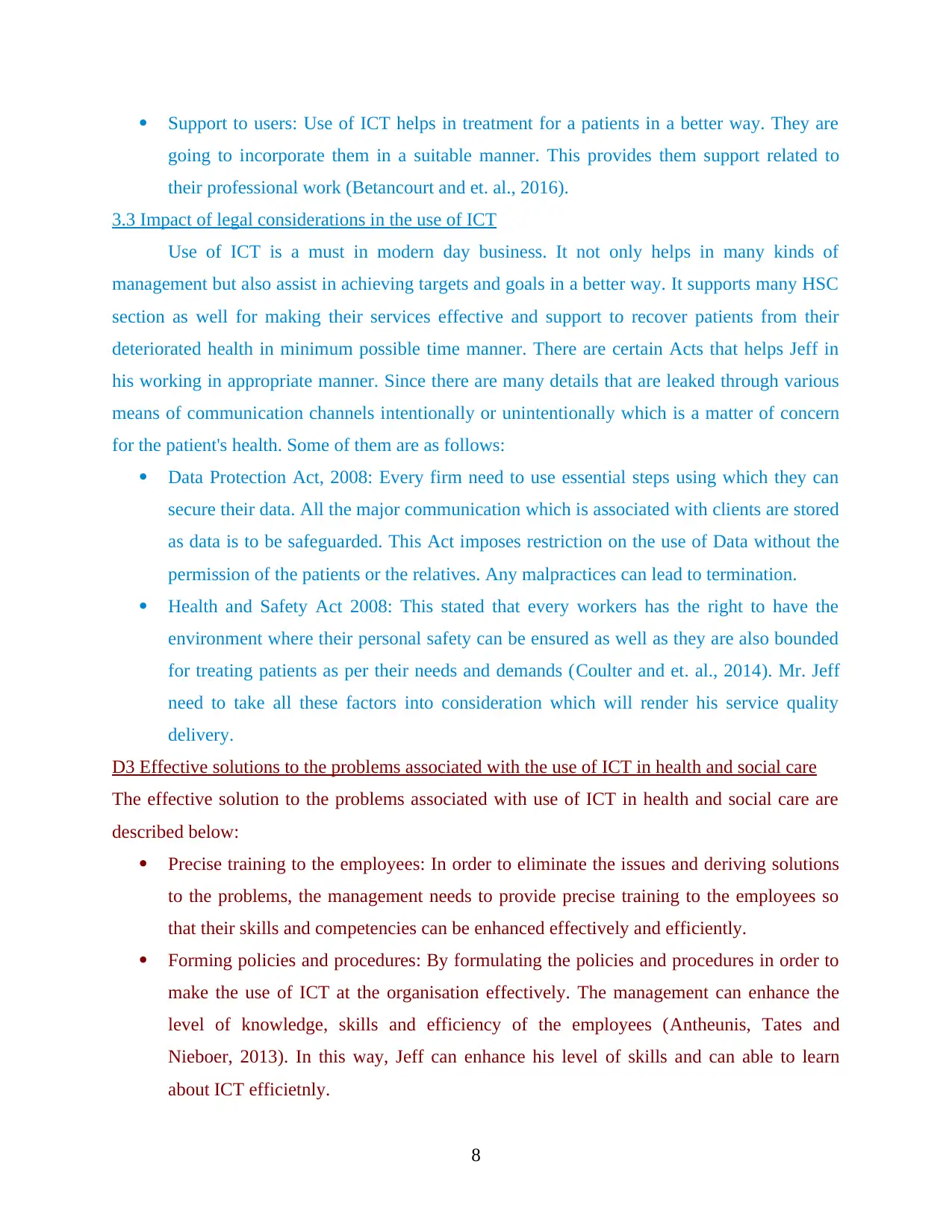
Support to users: Use of ICT helps in treatment for a patients in a better way. They are
going to incorporate them in a suitable manner. This provides them support related to
their professional work (Betancourt and et. al., 2016).
3.3 Impact of legal considerations in the use of ICT
Use of ICT is a must in modern day business. It not only helps in many kinds of
management but also assist in achieving targets and goals in a better way. It supports many HSC
section as well for making their services effective and support to recover patients from their
deteriorated health in minimum possible time manner. There are certain Acts that helps Jeff in
his working in appropriate manner. Since there are many details that are leaked through various
means of communication channels intentionally or unintentionally which is a matter of concern
for the patient's health. Some of them are as follows:
Data Protection Act, 2008: Every firm need to use essential steps using which they can
secure their data. All the major communication which is associated with clients are stored
as data is to be safeguarded. This Act imposes restriction on the use of Data without the
permission of the patients or the relatives. Any malpractices can lead to termination.
Health and Safety Act 2008: This stated that every workers has the right to have the
environment where their personal safety can be ensured as well as they are also bounded
for treating patients as per their needs and demands (Coulter and et. al., 2014). Mr. Jeff
need to take all these factors into consideration which will render his service quality
delivery.
D3 Effective solutions to the problems associated with the use of ICT in health and social care
The effective solution to the problems associated with use of ICT in health and social care are
described below:
Precise training to the employees: In order to eliminate the issues and deriving solutions
to the problems, the management needs to provide precise training to the employees so
that their skills and competencies can be enhanced effectively and efficiently.
Forming policies and procedures: By formulating the policies and procedures in order to
make the use of ICT at the organisation effectively. The management can enhance the
level of knowledge, skills and efficiency of the employees (Antheunis, Tates and
Nieboer, 2013). In this way, Jeff can enhance his level of skills and can able to learn
about ICT efficietnly.
8
going to incorporate them in a suitable manner. This provides them support related to
their professional work (Betancourt and et. al., 2016).
3.3 Impact of legal considerations in the use of ICT
Use of ICT is a must in modern day business. It not only helps in many kinds of
management but also assist in achieving targets and goals in a better way. It supports many HSC
section as well for making their services effective and support to recover patients from their
deteriorated health in minimum possible time manner. There are certain Acts that helps Jeff in
his working in appropriate manner. Since there are many details that are leaked through various
means of communication channels intentionally or unintentionally which is a matter of concern
for the patient's health. Some of them are as follows:
Data Protection Act, 2008: Every firm need to use essential steps using which they can
secure their data. All the major communication which is associated with clients are stored
as data is to be safeguarded. This Act imposes restriction on the use of Data without the
permission of the patients or the relatives. Any malpractices can lead to termination.
Health and Safety Act 2008: This stated that every workers has the right to have the
environment where their personal safety can be ensured as well as they are also bounded
for treating patients as per their needs and demands (Coulter and et. al., 2014). Mr. Jeff
need to take all these factors into consideration which will render his service quality
delivery.
D3 Effective solutions to the problems associated with the use of ICT in health and social care
The effective solution to the problems associated with use of ICT in health and social care are
described below:
Precise training to the employees: In order to eliminate the issues and deriving solutions
to the problems, the management needs to provide precise training to the employees so
that their skills and competencies can be enhanced effectively and efficiently.
Forming policies and procedures: By formulating the policies and procedures in order to
make the use of ICT at the organisation effectively. The management can enhance the
level of knowledge, skills and efficiency of the employees (Antheunis, Tates and
Nieboer, 2013). In this way, Jeff can enhance his level of skills and can able to learn
about ICT efficietnly.
8
Paraphrase This Document
Need a fresh take? Get an instant paraphrase of this document with our AI Paraphraser
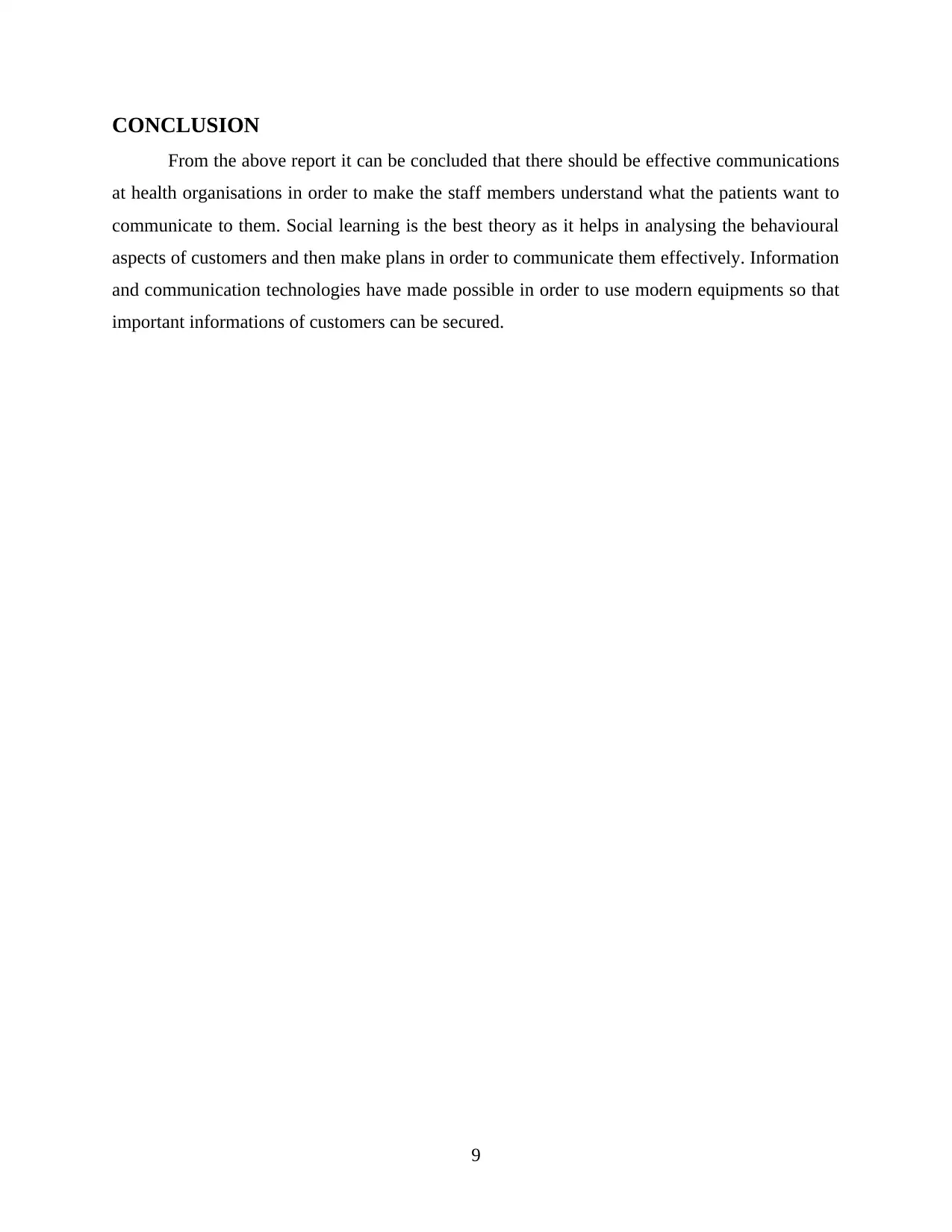
CONCLUSION
From the above report it can be concluded that there should be effective communications
at health organisations in order to make the staff members understand what the patients want to
communicate to them. Social learning is the best theory as it helps in analysing the behavioural
aspects of customers and then make plans in order to communicate them effectively. Information
and communication technologies have made possible in order to use modern equipments so that
important informations of customers can be secured.
9
From the above report it can be concluded that there should be effective communications
at health organisations in order to make the staff members understand what the patients want to
communicate to them. Social learning is the best theory as it helps in analysing the behavioural
aspects of customers and then make plans in order to communicate them effectively. Information
and communication technologies have made possible in order to use modern equipments so that
important informations of customers can be secured.
9
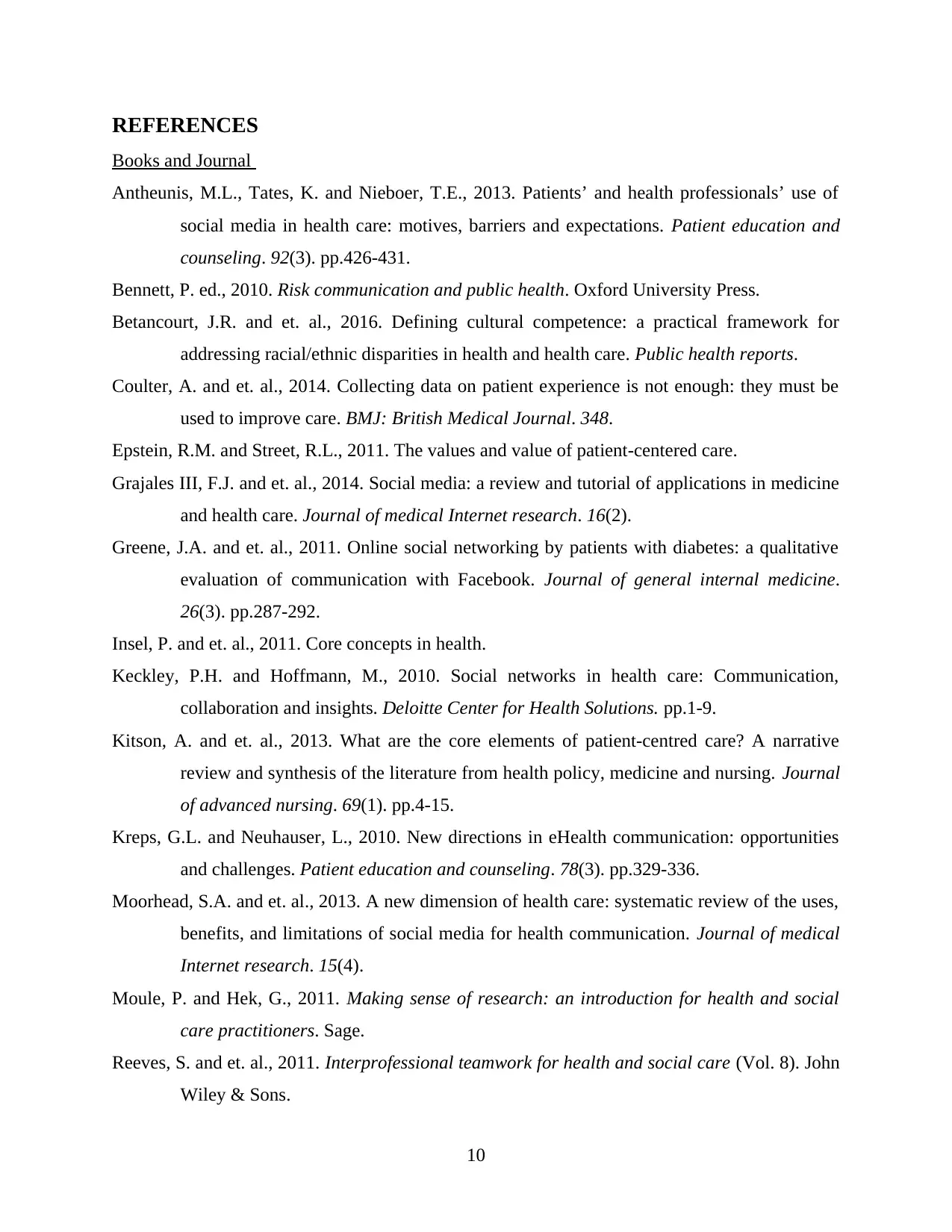
REFERENCES
Books and Journal
Antheunis, M.L., Tates, K. and Nieboer, T.E., 2013. Patients’ and health professionals’ use of
social media in health care: motives, barriers and expectations. Patient education and
counseling. 92(3). pp.426-431.
Bennett, P. ed., 2010. Risk communication and public health. Oxford University Press.
Betancourt, J.R. and et. al., 2016. Defining cultural competence: a practical framework for
addressing racial/ethnic disparities in health and health care. Public health reports.
Coulter, A. and et. al., 2014. Collecting data on patient experience is not enough: they must be
used to improve care. BMJ: British Medical Journal. 348.
Epstein, R.M. and Street, R.L., 2011. The values and value of patient-centered care.
Grajales III, F.J. and et. al., 2014. Social media: a review and tutorial of applications in medicine
and health care. Journal of medical Internet research. 16(2).
Greene, J.A. and et. al., 2011. Online social networking by patients with diabetes: a qualitative
evaluation of communication with Facebook. Journal of general internal medicine.
26(3). pp.287-292.
Insel, P. and et. al., 2011. Core concepts in health.
Keckley, P.H. and Hoffmann, M., 2010. Social networks in health care: Communication,
collaboration and insights. Deloitte Center for Health Solutions. pp.1-9.
Kitson, A. and et. al., 2013. What are the core elements of patient‐centred care? A narrative
review and synthesis of the literature from health policy, medicine and nursing. Journal
of advanced nursing. 69(1). pp.4-15.
Kreps, G.L. and Neuhauser, L., 2010. New directions in eHealth communication: opportunities
and challenges. Patient education and counseling. 78(3). pp.329-336.
Moorhead, S.A. and et. al., 2013. A new dimension of health care: systematic review of the uses,
benefits, and limitations of social media for health communication. Journal of medical
Internet research. 15(4).
Moule, P. and Hek, G., 2011. Making sense of research: an introduction for health and social
care practitioners. Sage.
Reeves, S. and et. al., 2011. Interprofessional teamwork for health and social care (Vol. 8). John
Wiley & Sons.
10
Books and Journal
Antheunis, M.L., Tates, K. and Nieboer, T.E., 2013. Patients’ and health professionals’ use of
social media in health care: motives, barriers and expectations. Patient education and
counseling. 92(3). pp.426-431.
Bennett, P. ed., 2010. Risk communication and public health. Oxford University Press.
Betancourt, J.R. and et. al., 2016. Defining cultural competence: a practical framework for
addressing racial/ethnic disparities in health and health care. Public health reports.
Coulter, A. and et. al., 2014. Collecting data on patient experience is not enough: they must be
used to improve care. BMJ: British Medical Journal. 348.
Epstein, R.M. and Street, R.L., 2011. The values and value of patient-centered care.
Grajales III, F.J. and et. al., 2014. Social media: a review and tutorial of applications in medicine
and health care. Journal of medical Internet research. 16(2).
Greene, J.A. and et. al., 2011. Online social networking by patients with diabetes: a qualitative
evaluation of communication with Facebook. Journal of general internal medicine.
26(3). pp.287-292.
Insel, P. and et. al., 2011. Core concepts in health.
Keckley, P.H. and Hoffmann, M., 2010. Social networks in health care: Communication,
collaboration and insights. Deloitte Center for Health Solutions. pp.1-9.
Kitson, A. and et. al., 2013. What are the core elements of patient‐centred care? A narrative
review and synthesis of the literature from health policy, medicine and nursing. Journal
of advanced nursing. 69(1). pp.4-15.
Kreps, G.L. and Neuhauser, L., 2010. New directions in eHealth communication: opportunities
and challenges. Patient education and counseling. 78(3). pp.329-336.
Moorhead, S.A. and et. al., 2013. A new dimension of health care: systematic review of the uses,
benefits, and limitations of social media for health communication. Journal of medical
Internet research. 15(4).
Moule, P. and Hek, G., 2011. Making sense of research: an introduction for health and social
care practitioners. Sage.
Reeves, S. and et. al., 2011. Interprofessional teamwork for health and social care (Vol. 8). John
Wiley & Sons.
10
⊘ This is a preview!⊘
Do you want full access?
Subscribe today to unlock all pages.

Trusted by 1+ million students worldwide
1 out of 13
Related Documents
Your All-in-One AI-Powered Toolkit for Academic Success.
+13062052269
info@desklib.com
Available 24*7 on WhatsApp / Email
![[object Object]](/_next/static/media/star-bottom.7253800d.svg)
Unlock your academic potential
Copyright © 2020–2025 A2Z Services. All Rights Reserved. Developed and managed by ZUCOL.





